

Star Wars Origins - Joseph Campbell and the Hero's Journey. In 1949 Joseph Campbell (1904-1987) made a big splash in the field of mythology with his book The Hero With a Thousand Faces.

This book built on the pioneering work of German anthropologist Adolph Bastian (1826-1905), who first proposed the idea that myths from all over the world seem to be built from the same "elementary ideas. " Swiss psychiatrist Carl Jung (1875-1961) named these elementary ideas "archetypes," which he believed to be the building blocks not only of the unconscious mind, but of a collective unconscious. In other words, Jung believed that everyone in the world is born with the same basic subconscious model of what a "hero" is, or a "mentor" or a "quest," and that's why people who don't even speak the same language can enjoy the same stories. Campbell's contribution was to take this idea of archetypes and use it to map out the common underlying structure behind religion and myth. NASA Shows Us a Blue Sunset on Mars. Have you ever wondered what a sunset would look like on Mars?

Wonder no more, because this video from NASA shows just what you’d see at the end of a Martian day. This video is made of images taken by NASA’s Opportunity rover between November 4th and 5th, 2010. A few of the frames are enhanced or simulated to give the movie a better flow, but this is as close to a real Martian sunset as human eyes will see for at least a generation. And it looks nothing like a sunset does on Earth. On Earth, incoming sunlight is scattered in all directions by the gases and particles in our atmosphere. The same thing happens on Mars, but because the atmospheric composition is different, light scatters differently to give the Martian sky its characteristic red hue. Just like a sunset on Earth, the sunsets on Mars pass sunlight through more atmosphere, scattering light such that some blue light survives, making for a blue sunset.
NASA "Discovers" Martian Ocean that Hoagland and Bara Predicted 14 years Ago. Today, NASA announced with great fanfare the "discovery" of a large ocean covering the northern hemisphere of Mars that they say may have existed billions of years ago.

The fact is that this ocean was actually discovered and predicted by myself and Richard Hoagland over 14 years ago in our Mars Tidal Model paper published on www.enterprisemission.com. While I'm gratified that NASA has finally admitted that Hoagland and me were correct all those years ago, I wish they'd get the details right. The fact is that this ocean wasn't always in the northern plains, it was in fact held in place around the equator by the tidal forces from the planet, "Plant V" that Mars used to be in a tidal locked orbit around. All of this is covered in our Mars Tidal Model paper that we published online in 2001 after it was rejected by scientific journals because there was "no scientific evidence" to support our ideas. Hmm. Mars once had an ocean with more water than the Arctic – NASA — RT News. Published time: March 06, 2015 02:23 Edited time: March 06, 2015 06:32 An artist's impression of ancient Mars and its oceans based on geological data (Image from wikipedia.org) Analysis of water residue in Martian ice caps indicates that the Red Planet was once – at least partly – blue.
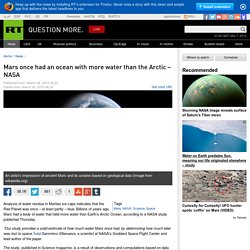
Billions of years ago, Mars had a body of water that held more water than Earth’s Arctic Ocean, according to a NASA study published Thursday. “Our study provides a solid estimate of how much water Mars once had, by determining how much later was lost to space,”said Geronimo Villanueva, a scientist at NASA’s Goddard Space Flight Center and lead author of the paper. Terraforming Mars.
If we really want to live on Mars, we’re going to need to do a complete renovation.
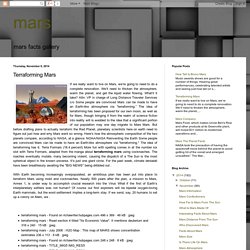
We’ll need to thicken the atmosphere, warm the planet, and get the liquid water flowing. What’ll it take? Attn: VP in charge of Long Distance Traveler Services c/o Some people are convinced Mars can be made to have an Earth-like atmosphere via “terraforming.” The idea of terraforming has been proposed for our own moon, as well as for Mars, though bringing it from the realm of science fiction into reality will is wedded to the idea that a significant portion of our population may one day migrate to Mars Mars. But before drafting plans to actually terraform the Red Planet, planetary scientists here on earth need to figure out just how and why Mars went so wrong. With Earth becoming increasingly overpopulated, an ambitious plan has been put into place to terraform Mars using mold and cockroaches. 'Great Desert = Mars Maps 1. A Beautifully Detailed New Geologic Map of Mars. It took 16 years and data from four orbiting spacecraft to assemble, but the U.S.
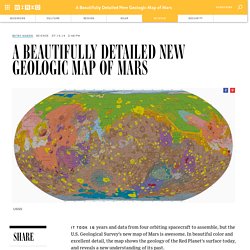
NASA - Home. Mars. Animation of Mars' rotation from the vantage of an observer who moves south, then north, to hover over both poles, showing the planet's major topographic features.
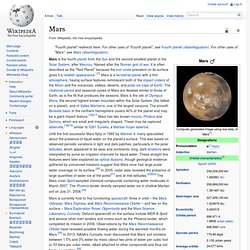
Mars is currently host to five functioning spacecraft: three in orbit – the Mars Odyssey, Mars Express, and Mars Reconnaissance Orbiter – and two on the surface – Mars Exploration Rover Opportunity and the Mars Science Laboratory Curiosity. Defunct spacecraft on the surface include MER-A Spirit and several other inert landers and rovers such as the Phoenix lander, which completed its mission in 2008. Observations by the Mars Reconnaissance Orbiter have revealed possible flowing water during the warmest months on Mars.[25] In 2013, NASA's Curiosity rover discovered that Mars' soil contains between 1.5% and 3% water by mass (about two pints of water per cubic foot or 33 liters per cubic meter, albeit attached to other compounds and thus not freely accessible).[26] Physical characteristics.
Geography of Mars / Mars Express / Space Science. Geography of Mars The Valles Marineris hemisphere of Mars Although Mars is a small planet – its radius is just a little over half of Earth's – we now know that it boasts scenery on a scale that makes Mount Everest and the Grand Canyon seem unimpressive by comparison.
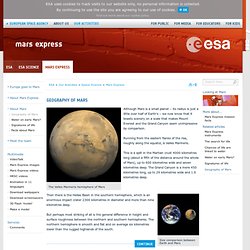
Running from the eastern flanks of the rise, roughly along the equator, is Valles Marineris. This is a split in the Martian crust 4000 kilometres long (about a fifth of the distance around the whole of Mars), up to 600 kilometres wide and seven kilometres deep. The Grand Canyon is a mere 450 kilometres long, up to 29 kilometres wide and 1.6 kilometres deep. Size comparison between Earth and Mars Then there is the Hellas Basin in the southern hemisphere, which is an enormous impact crater 2300 kilometres in diameter and more than nine kilometres deep. Mars Odyssey Mission THEMIS. Interactive Mars Data Maps.
Mars Exploration Program. Mars.